
views
Deciding Whether Testosterone Therapy is Appropriate
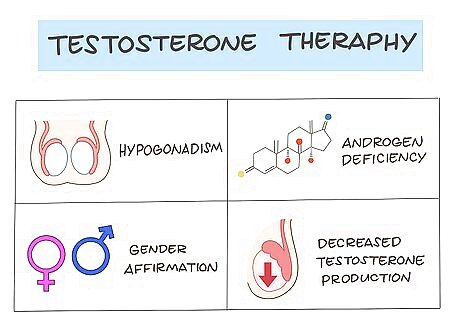
Know when and why testosterone is prescribed. People seek testosterone treatments for a variety of medical conditions. Testosterone is commonly prescribed to treat hypogonadism in men - a condition that develops when the testes don't function correctly. However, this is far from the only reason why someone might want testosterone. Below are just a few other reasons: Testosterone is sometimes given to transgender people as part of their gender affirmation and transition. Some women receive testosterone as a treatment for androgen deficiency, which can occur after menopause. The most common symptom of androgen deficiency in women is decreased libido. Finally, some men seek testosterone treatment to counteract the normal effects of decreased testosterone production that results with aging. However, this practice is still not well-studied, so many physicians advise against it. Some of the studies that have been done have given mixed results.
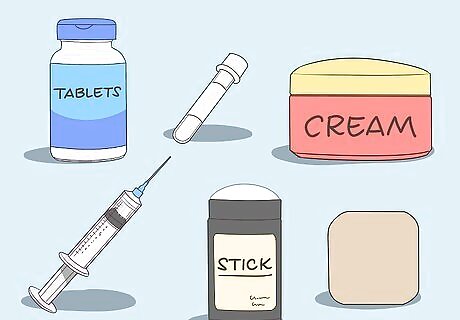
Know alternative methods of administration. Injection is a commonly-used means of administering testosterone to a patient. However, there are actually a wide range of alternative methods for getting testosterone in to the body, some of which may be preferable to certain patients. These include: Topical gel or cream Skin patch (similar to a nicotine patch) Oral tablets Mucoadhesive applied to the teeth Testosterone stick (applied under the arm like deodorant) Subcutaneous implant
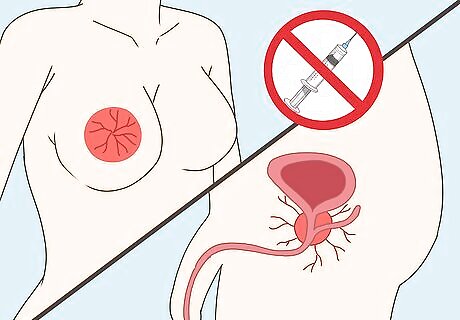
Know when testosterone should not be administered. Because testosterone is a hormone that can cause significant changes in your body's function, it is known to exacerbate or worsen certain medical conditions. Testosterone should not be administered if a patient suffers from prostate cancer or breast cancer. All patients considering testosterone treatment should receive a prostate exam and a screening for prostate-specific-antigen (PSA) before and after therapy to make sure prostate cancer is not present.

Understand the side effects of testosterone therapy. Testosterone is a fairly powerful hormone. Even with safe, doctor-monitored use, it can have noticeable side effects. The most common side effects from testosterone treatment are: Acne and/or oily skin Fluid retention Stimulation of prostate tissue, which can result in decreased urine flow and frequency Development of breast tissue Worsening of sleep apnea Shrinking of the testes Decreased sperm count/infertility Increase in red blood cell count Changes in cholesterol levels
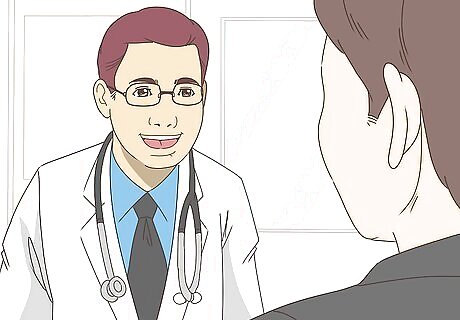
Consult with a doctor. Like any serious medical treatment, the decision to receive testosterone treatment shouldn't be made lightly. Seek the advice of your doctor before proceeding - s/he will be able to help you assess your condition and goals to determine whether testosterone is right for you.
Performing a Testosterone Injection
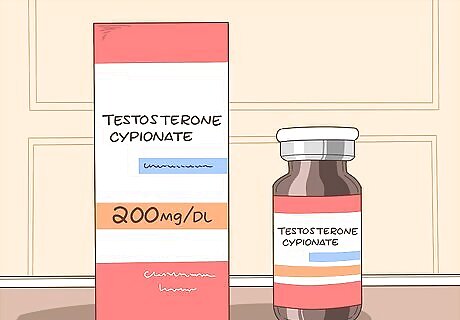
Identify the concentration of your testosterone. Testosterone for injection is usually in the form of testosterone cypionate or testosterone enanthate. These liquids come in multiple concentrations, so before giving an injection, it's very important to make sure that your intended dosage takes into account the concentration of the testosterone serum. Usually, testosterone comes in a concentration of either 100 mg/mL or 200 mg/mL. In other words, some doses of testosterone are twice as concentrated as others. Double check your testosterone before you give an injection to make sure you have the right dosage for the concentration you've chosen.
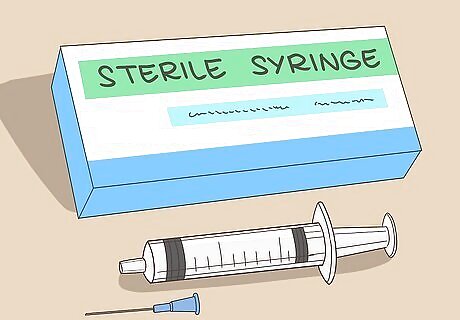
Use a sterile, suitable needle and syringe. As with all injections, it's tremendously important to use a sterile, never-before-used needle when administering testosterone. Dirty needles can spread deadly blood-borne diseases like hepatitis and HIV. Use a clean, sealed, capped needle every time you give a testosterone injection. Another thing to consider is the fact that testosterone is fairly viscous and oily compared to other injectable medications. Because of this, you'll want to initially use a slightly thicker-bore needle than normal (for instance, a 18 or 20-gauge) to draw up your dose. Thick needles can be especially painful, so, usually, you'll remove the thicker needle and replace it with a thinner one when it comes time to give the actual injection. 3-mL (cc) syringes will be large enough for most testosterone doses. If you drop the syringe or needle, throw it away. Do not use it because it is no longer sterile.
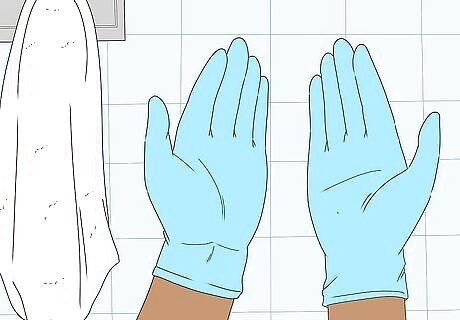
Wash your hands and put on clean gloves. To reduce the risk of infection, it's important to keep your hands clean when giving an injection. Wash your hands thoroughly with antibacterial soap and water, then put on clean gloves. If you accidentally touch any unsanitized objects or surfaces before giving the injection, replace your gloves as a safety measure.
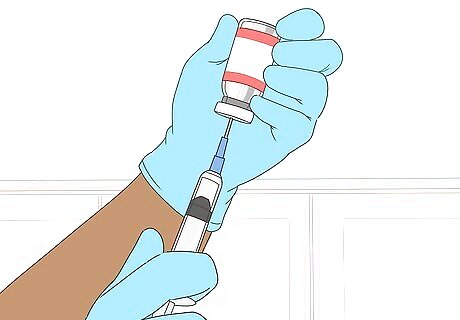
Draw up a dose. Your doctor will have given you a recommended dose - determine the volume of your dose in relation to the concentration of your testosterone. For instance, if your doctor recommends a dose of 100 mg, you'll want 1 milliliter (0.034 fl oz) of a 100 mg/mL testosterone solution or ½ mL of a 200 mg/mL solution. To draw up your dose, first draw air into your syringe equal to the volume of your dosage. Then, wipe the top of the medication bottle with an alcohol wipe, insert your needle through the lid and into the medication, and push the air from your syringe into the bottle. Turn the bottle upside down and draw out the exact dosage of testosterone. Injecting air into the bottle raises its internal air pressure, making it easier to draw the medication into the syringe. This is especially important with testosterone, which can be difficult to draw because it's so thick.
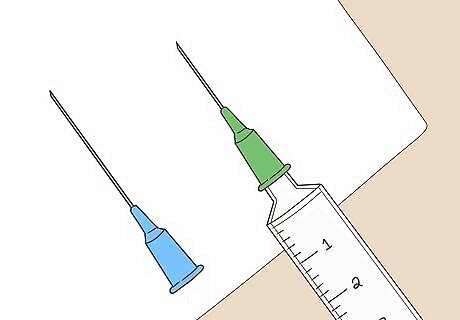
Switch to a smaller needle. Thick needles can be fairly painful. There's no need to subject yourself to this extra pain, especially if you're on a program that calls for frequent injections. To switch to a smaller needle once you've drawn up your dose, remove the needle from the bottle and hold it point-up in front of you. Draw a small amount of air - this is to put space between the medicine and the top of the syringe so that you don't spill. Using the (washed and gloved) hand that's not holding the syringe, carefully re-cap and unscrew the needle, then replace it with a thinner one (like a 23-gauge). Note that the second needle must also be sealed and sterile.
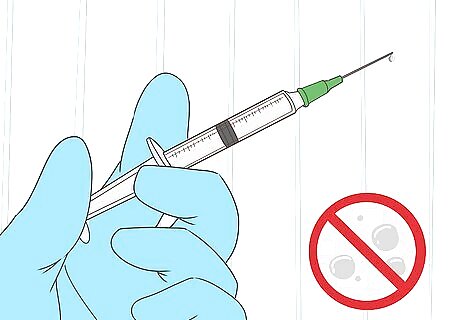
Aspirate the syringe. Injecting air bubbles into a person's body can cause a serious medical condition called an embolism. Because of this, it's very important to ensure there are no air bubbles in the syringe when you inject the testosterone. Do this via a process called aspiration. See below for instructions: Hold the syringe with its needle uncapped and pointing up in front of you. Look for air bubbles in the syringe. Flick the side of the syringe to get these bubbles to rise to the top. When your dosage is bubble-free, slowly depress the plunger to force the air at the top of the syringe out. Stop when you see a tiny drop of medication come out of the tip of the syringe. Be careful not to squirt or spray a significant portion of your dosage onto the floor.

Prepare the injection site. Testosterone injections are typically intramuscular - that is, given directly into a muscle. Two relatively easy and accessible sites for intramuscular injection are the vastus lateralis (top outside region of the thigh) or the glut (upper back portion of the thigh, ie, the butt cheek). These aren't the only places that testosterone can be injected, but they are by far the most common. Whichever of these sites you choose, take a sterile alcohol pad and wipe the immediate area around where you intend to inject. This will kill bacteria on the skin, preventing infection. If injecting into the glute, choose an injection site in the top outside section of the glute. In other words, pick a site either in the top left corner of the left glute or the top right corner of the right glute. These site have the best access to muscle tissue and allow you to avoid hitting nerves and blood vessels in other parts of the glute.
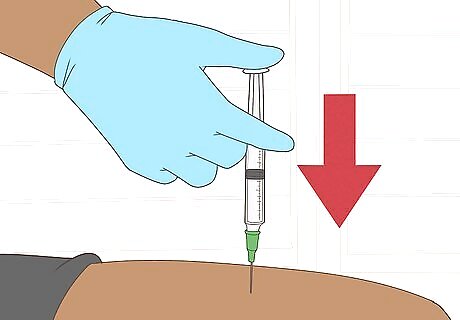
Inject. Hold your loaded syringe like a dart at a 90 degree angle above the sterile injection site. Quickly plunge it into the flesh using one quick, steady motion. Before depressing the plunger, draw back on it slightly. If you draw blood into the syringe, remove the needle and choose a different spot, as this means you've hit a vein. Inject the medication at a steady, controlled pace. You may experience moderate discomfort, pressure, stinging, pressure, or slight burning. This is normal. If it becomes severe or if you feel shooting pain, stop immediately, and contact a doctor.
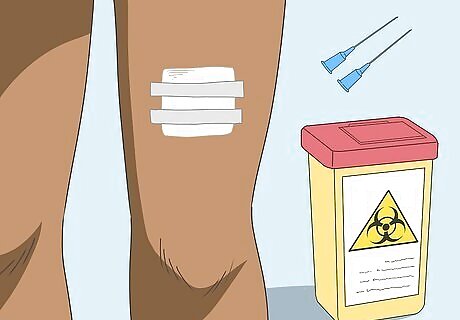
Care for the injection site post-injection. Once you have fully depressed the plunger, slowly pull the needle out. Assess the needle entry point for bleeding, and apply a sterile band-aid and/or a clean cotton ball if needed. Dispose of the used needle and syringe in a proper sharps container. If you do not have a sharps container, find a sturdy, puncture-proof container, such as a laundry detergent bottle. Make sure that it has a tight-fitting lid. Take the container to your doctor's office or a pharmacy to be safely disposed of. If, after injection, you experience redness, swelling, or discomfort beyond that of normal soreness at the site of injection, contact a physician immediately.




















Comments
0 comment